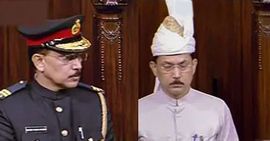A tweet by an ex-Army chief is as powerful as a gunshot. This was most recently seen when Gen V.P. Malik, who led the Army during the Kargil war, questioned on Twitter the decision to provide Rajya Sabha marshals with uniforms resembling that of top military officers.
The two middle-aged marshals, who help Vice President Venkaiah Naidu conduct Rajya Sabha proceedings, recently traded their traditional white attire and turban for a dark-blue uniform with braided peaked cap. Eyebrows were raised, and Naidu, ever sensitive to public perception, immediately ordered a re-look at the change.
The change in uniform, however, reflected a long-term grievance of officials serving successive vice presidents. The officials had long been pointing out that the vice president, who is next only to the president in protocol, lacked an aide-de-camp from the military. For several decades, the vice president’s office had been hinting that it would serve the dignity of the vice president if he were to be accompanied by ADCs, rather than by just personal security officers. But the defence ministry and the Rashtrapati Bhavan, which deal with protocol-related matters, could not come to an agreement.
The president has five ADCs, one of whom always shadows him. There is also the military secretary and the deputy military secretary, who, along with the ADCs, are drawn from the Army, the Navy and the Air Force. On ceremonial occasions, all seven personnel march in slow time as the president arrives and departs. In addition, there is the president’s mounted bodyguard, also drawn from an Army unit.
Though they are below the vice president in the pecking order, governors have two ADCs. They take salute at Republic Day parades in state headquarters, like the president does on Delhi’s Rajpath. In many states, the Army has persuaded governors to recruit ADCs from the state police. The Army found that some governors tried to make ADCs, usually captains or their equivalent, do non-protocol work. Malik was among the chiefs who felt that deploying 60-odd captains in state capitals could be avoided, as young officers were needed for military work.
The vice president does not have any military responsibility, even though he is entitled to use Air Force planes and helicopters. K.R. Narayanan, who served as both vice president and president, insisted that the vice president’s personal security officer, who sits next to the president’s ADC, should know protocol, be well-educated, should be conversant in both Hindi and English, and wear a smart suit in winter and safari jacket in summer. He banished security officers in shirtsleeves and sweaters.
The Rajya Sabha marshals had been complaining that their uniform and headgear resembled that of the junior personnel who supplied water and stationery to MPs. Since they served the chairman of the Rajya Sabha, they wanted a distinctive dress. The secretariat, while granting the demand, did not realise the gaffe it made by allowing the officials to choose their uniform. Interestingly, Lok Sabha Speaker Om Birla, who is also served by two marshals, did not think it necessary to upgrade their uniforms.
Gen Malik tweeted that providing military uniforms to non-military personnel was illegal and a security hazard. When he was Army chief, he had directed employees of private security agencies to not wear the Army’s olive green. Private guards were given a distinctive dress code.
The Rajya Sabha marshals may now be barred from using three colours—the Army’s olive green, the Navy’s white and the Air Force’s blue. And, they may not like to sport the Rajya Sabha’s official colour—red!
sachi@theweek.in


